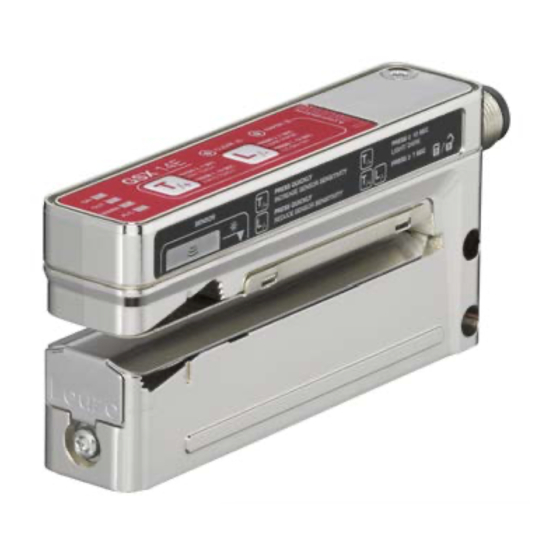
Summary of Contents for Leuze GSX14E
- Page 1 Ultrasonic label fork GSX 14E Leuze electronic GmbH + Co. KG In der Braike 1 73277 Owen Tel.: +49 7021 573-0 info@leuze.com • www.leuze.com...
- Page 2 1Figure part...
- Page 3 2-7 s 2-7 s 7-12 s...
- Page 4 > 12 s 7-12 s > 12 s...
- Page 5 – < 2 s < 2 s > 7 s ≥ 20 ms ≥ 20 ms HIGH...
- Page 6 14 mm...
-
Page 7: Intended Use
Intended use The ultrasonic label forks are ultrasonic sensors for contactless detection of the gap between two consecutive labels on a carrier tape. NOTICE Observe intended use! This product is not a safety sensor and is not intended as personnel protection. - Page 8 A Ultrasonic detection process position B Optical detection process position C Label run Ä To achieve a high switching accuracy, place the label tape on the lower fork with slight tension. Ä Orient the label tape so that it is guided both under the " Ultrasonic detection process position"...
- Page 9 Select active detection process The GSX14E forked sensor can detect label gaps with the ultrasonic detection process or with the optical detection process. – In many cases, labels can, in principle, be reliably detected with both detec- tion processes. – The advantage of the optical detection process over the ultrasonic detection process is that it has better repeatability, even at high conveyor speeds –...
- Page 10 easy Teach while the label tape is passing through (dynamic) During the easy Teach process, a two-point calibration is performed on the carrier and the label. NOTICE With respect to detection reliability, the easy Teach process is gener- ally to be preferred over the static teach process. Preparation: Insert label tape into the sensor.
- Page 11 Manual mode With manual easy Teach , the operator selects the detection process ( ultrasonic or optical ) in advance ("Configuration of the easy Teach mode"). NOTICE Ä To switch the easy Teach mode from intelligent to manual , press the label button for longer than 12 seconds. With manual easy Teach , the operator can deliberately teach a label with a spe- cific detection process.
- Page 12 Static teach on the label carrier without transport With the static teach process, a one-point calibration is performed on the blank carrier. This process is especially advantageous because no labels are lost while teaching. NOTICE After the teach event is ended, the sensor does not automatically se- lect the appropriate detection process ( ultrasonic or optical ) but rather operates with the detection process that was active before the teach event was started.
- Page 13 ALC (Auto Level Control) function With the ALC function, the sensor automatically corrects the switching threshold in such a way that the maximum function reserve is always available during opera- tion. NOTICE The ALC function is active by default and is indicated by illumination of the yellow ALC LED.
- Page 14 Activate or deactivate ALC function The ALC function can be manually deactivated and activated. Manual deactivation/activation of the ALC function is always only performed for the respective active detection process. The ALC function remains deactivated for the active detection process until it is manually reactivated by the operator.
- Page 15 easyTune – Manual fine tuning of the switching threshold With homogeneous label material, the signal in the gap between two labels is much larger compared to the signal on the label. For the taught switching threshold, there is a high function reserve in both the gap as well as on the label, and the sensor functions reliably.
- Page 16 Recommended settings Observation Measure Action Repeatedly press the la- After teaching, the yellow Reduce sensitivity of the LED and the switching sensor bel button (-) briefly until output flicker if the label is (upward shift of the the sensor detects the moved through the sen- switching threshold) moving label stably and...
- Page 17 Sensor adjustment via teach input (pin 5) Teach-in To teach, a teach signal is applied to the teach input (pin 5). The duration of the teach signal (low level on the teach input) determines the teach-in function. NOTICE Before a low level is applied for teaching-in functions, a high level must be applied for at least 20 ms.
- Page 18 Locking the buttons via the teach input Manual locking of the buttons on the device is only suitable for protecting against tampering to a limited extent since locking can be canceled using the correspond- ing button combination. For this reason, it is also possible to lock the buttons via the teach input (pin 5).
- Page 19 Handling narrow labels The distance between the markings of the ultrasonic and optical detection pro- cesses is 14 mm. For reliable and successful teaching, labels that are not wider than 14-18 mm should only be guided under one of the two available markings, ultrasonic or opti- cal .















Need help?
Do you have a question about the GSX14E and is the answer not in the manual?
Questions and answers